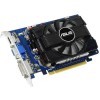- Qualcomm Launches Snapdragon 4 Gen 2 Mobile Platform
- AMD Launches Ryzen PRO 7000 Series Mobile & Desktop Platform
- Intel Launches Sleek Single-Slot Arc Pro A60 Workstation Graphics Card
- NVIDIA Announces Latest Ada Lovelace Additions: GeForce RTX 4060 Ti & RTX 4060
- Maxon Redshift With AMD Radeon GPU Rendering Support Now Available
ASUS GeForce 210, GT 220 & GT 240

This past fall, NVIDIA filled out the remainder of its GT200 series of graphics cards with three models. For basic computing, there’s the $40 GeForce 210, while for those looking to get a bit of light gaming done, there’s the $60 GT 220. And to round things off, there’s the $90 GT 240, which handles all of today’s games rather well at 1080p.
Page 3 – Call of Duty: Modern Warfare 2
When the original Call of Duty game launched in 2003, Infinity Ward was an unknown. Naturally… it was the company’s first title. But since then, the series and company alike have become household names. Not only has the series delivered consistently incredible gameplay, it’s pushed the graphics envelope with each successive release, and where Modern Warfare is concerned, it’s also had a rich storyline.
The first two titles might have been built on the already-outdated Quake III engine, but since then, the games have been built with improved graphical features, capable of pushing the highest-end PCs out there. Modern Warfare 2 is the first such exception, as it’s more of a console port than a true PC title. Therefore, the game doesn’t push PC hardware as much as we’d like to see, but despite that, it still looks great, and lacks little in the graphics department. You can read our review of the game here.
Manual Run-through: The level chosen is the 10th mission in the game, “The Gulag”. Our teams fly in helicopters up to an old prison with the intention of getting closer to finding the game’s villain, Vladimir Makarov. Our saved game file begins us at the point when the level name comes on the screen, right before we reach the prison, and it ends after one minute of landing, following the normal progression of the level. The entire run takes around two-and-a-half minutes.

To kick things off, the 210 proves that it is indeed faster than an IGP, at least Intel’s, but the GT 220 is the dominant model. It’s far faster than the 210, and it’s proven in the graph above.


Compared to AMD’s Radeon HD 5670, NVIDIA falls just a wee bit behind. Both of these cards can be directly compared performance-wise, as both retail for around the same price and target the same crowd. For what it’s worth, though, the HD 5670 isn’t being sold for under $100 by any e-tailer that I can see at the current time, but NVIDIA’s card can be had for $85, or even less with MIR’s. But, AMD does have the advantage of improved power efficiency, Eyefinity and DirectX 11… plus it’s seemingly faster, so both cards might come out even depending how heavily you weigh various factors.
|
Graphics Card
|
Best Playable
|
Min FPS
|
Avg. FPS
|
|
ATI HD 5770 1GB CrossFireX
|
2560×1600 – Max Detail, 4xAA
|
40
|
81.311
|
|
ATI HD 5870 1GB (Sapphire)
|
2560×1600 – Max Detail, 4xAA
|
46
|
79.838
|
|
ATI HD 5850 1GB (ASUS)
|
2560×1600 – Max Detail, 4xAA
|
37
|
68.563
|
|
NVIDIA GTX 285 1GB (EVGA)
|
2560×1600 – Max Detail, 4xAA
|
41
|
66.527
|
|
NVIDIA GTX 275 896MB (Reference)
|
2560×1600 – Max Detail, 4xAA
|
37
|
61.937
|
|
NVIDIA GTX 260 896MB (XFX)
|
2560×1600 – Max Detail, 4xAA
|
33
|
53.314
|
|
ATI HD 5770 1GB (Reference)
|
2560×1600 – Max Detail, 0xAA
|
36
|
60.337
|
|
NVIDIA GTS 250 1GB (EVGA)
|
2560×1600 – Max Detail, 0xAA
|
30
|
53.253
|
|
ATI HD 5750 1GB (Sapphire)
|
2560×1600 – Max Detail, 0xAA
|
28
|
50.727
|
|
ATI HD 5670 512MB (Reference)
|
1920×1080 – Max Detail, 4xAA
|
24
|
43.96
|
|
NVIDIA GT 240 512MB (ASUS)
|
1920×1080 – Max Detail, 0xAA
|
30
|
53.139
|
|
NVIDIA GT 220 1GB (ASUS)
|
1280×1024 – Low Detail, 0xAA
|
29
|
53.593
|
|
NVIDIA 210 512MB (ASUS)
|
1280×1024 – Low Detail, 0xAA
|
18
|
29.885
|
|
Intel HD Graphics (Clarkdale)
|
1280×1024 – Low Detail, 0xAA
|
14
|
25.955
|
The GT 240 is quite the heavyweight when compared to the others we’re looking at. It handled the game just fine at 1080p with anti-aliasing removed, delivering a full 53 FPS. The others, including Intel’s IGP, managed to handle the game decent with low details at 1280×1024. The GT 220 clearly offers the best experience, but the others will suffice if you’re not set on silky-smooth frame-rates.
Support our efforts! With ad revenue at an all-time low for written websites, we're relying more than ever on reader support to help us continue putting so much effort into this type of content. You can support us by becoming a Patron, or by using our Amazon shopping affiliate links listed through our articles. Thanks for your support!






